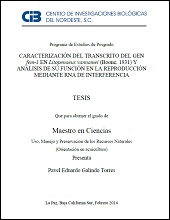Caracterización del transcrito del gen fem-1 en Litopenaeus vannamei (Boone, 1931) y análisis de su función en la reproducción mediante RNA de interferencia
Author
PAVEL EDUARDO GALINDO TORRES
Metadata
Show full item recordAbstract
"Litopenaeus vannamei es uno de los peneidos más importantes a nivel mundial dado que presenta características de importancia para su cultivo, entre las que destaca su dimorfismo sexual en talla y peso durante su desarrollo, en el cual las hembras adquieren mayor tamaño que los machos. Lo anterior perfila a L. vannamei como un modelo para el estudio de los mecanismos involucrados en la determinación/diferenciación sexual como una aproximación a la posible ventaja para el cultivo de camarones a través del monocultivo de hembras. Para ello es necesario profundizar en el estudio de las variables genéticas durante este proceso, principalmente para entender los mecanismos de regulación involucrados durante la diferenciación sexual, analizando los diferentes genes conocidos e identificados previamente en otras especies de invertebrados. Particularmente en Caenorhabditis elegans el proceso de determinación sexual ha sido bien estudiado, el cual inicia con una señal primaria constituida por genes sensibles a la dosis cromosómica, resultando en una cascada de señalización genética que da lugar a la diferenciación sexual tanto de la línea somática como germinal. Entre los genes involucrados en esta vía se encuentra fem-1, un gen que se ha conservado desde los invertebrados hasta los vertebrados; su función ha sido establecida a partir del silenciamiento genético, mostrando perfiles de feminización en ambas líneas celulares cuando éste es bloqueado. Así mismo la proteína FEM-1 regula mediante interacciones del tipo proteína-proteína los genes requeridos para la diferenciación sexual. Entre los genes regulados indirectamente se encuentra el de la vitelogenina el cual es mediado negativamente en machos. Por lo que el objetivo principal de este trabajo fue caracterizar el transcrito del gen feminization of XX and X0 animals (fem-1) expresado en hembras y machos de L. vannamei, y establecer su papel en la diferenciación sexual. Se logró aislar y caracterizar cinco transcritos completos del gen, el cual presentó variación de longitud en dirección 5’; todos los transcritos contenían el domino conservado de repeticiones ankyrin..." "Litopenaeus vannamei is one of the most important Penaeidae at world level because it has important characteristics for its farming, as its sexual dimorphism in size and weight during development when females acquire a larger size than males. Thus L. vannamei is a model for the study of the mechanisms involved in sexual determination/differentiation as an approximation to the possible advantage for shrimp farming through female monoculture. As a result, it is necessary to go more in depth in the study of genetic variables during this process, principally in understanding the regulation mechanism involved during sexual differentiation, analyzing the different genes previously known and indentified in other invertebrate species. The process of sexual determination has been well studied, particularly in Caenorhabditis elegans, which begins with a primary signal constituted by a chromosomal sensitive gene dose, resulting in a cascade of genetic signaling and giving place to sexual differentiation in both somatic and germ lines. Among the genes involved in this pathway is fem-1, a gene that has been conserved from vertebrates to invertebrates, whose function has been established from gene silencing showing feminization profiles in both cell lines when it is blocked. Similarly, the FEM-1 protein is regulated by protein-protein interactions, the gene types required for sexual differentiation. Vitellogenin, which is negatively mediated into male, is indirectly found among the regulated genes,. Whereby the principal objective of this work was to characterize the transcript of the feminization XX X0 animal (fem-1) genes expressed in both L. vannamei females and males to establish their role in sexual differentiation. The isolation and characteristics of the five full-length transcripts of the gene were achieved, showing a length variation in the 5’ directions. All of the transcripts contained the conserved domain of the Ankyrin repetitions. A transcript of 3378 pb was isolated from all the evaluated tissues (male and female gonad, embryo, and the juvenile female eyestalk); its proteic prediction showed high structural similarity with region D34 of human ANKYRIN-R that has been associated with the function in the cellular membrane periphery as well as a link to transcription factors..."
Collections
Related items
Showing items related by title, author, creator and subject.
-
PROMOCIÓN DEL PERIFITON PARA EL CULTIVO DE CAMARÓN BLANCO: HACIA UNA ACUICULTURA ECOLÓGICA
DOMENICO VOLTOLINA LOBINA; JUAN MANUEL AUDELO NARANJO; MARIA DEL ROSARIO PACHECO MARGES -
Suelo y Erosión
YOLANDA LOURDES MAYA DELGADO


